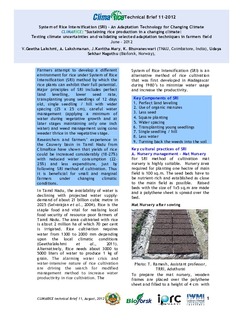| dc.contributor.author | Geethalakshmi, V. | |
| dc.contributor.author | Lakshmanan, A. | |
| dc.contributor.author | Kavitha, Mary, J. | |
| dc.contributor.author | Bhuvaneswari, K. | |
| dc.contributor.author | Nagothu, Sekhar | |
| dc.coverage.spatial | India, Tamil Nadu, Andhra Pradesh | nb_NO |
| dc.date.accessioned | 2017-10-09T12:55:55Z | |
| dc.date.available | 2017-10-09T12:55:55Z | |
| dc.date.created | 2017-10-09T13:48:04Z | |
| dc.date.issued | 2012-06 | |
| dc.identifier.uri | http://hdl.handle.net/11250/2459230 | |
| dc.description.abstract | Farmers attempt to develop a different environment for rice under System of Rice Intensification (SRI) method by which the rice plants can exhibit their full potential. Major principles of SRI includes perfect land levelling, lower seed rate, transplanting young seedlings of 12 days old, single seedling / hill with wider spacing (25 x 25 cm), careful water management (applying a minimum of water during vegetative growth and at later stages maintaining only one inch water) and weed management using cono weeder thrice in the vegetative stage. Researchers and farmers’ experience in the Cauvery basin in Tamil Nadu from ClimaRice have shown that yields of rice could be increased considerably (18–27%) with reduced water consumption (22- 25%) and less expenditure, just by following SRI method of cultivation. Thus it is beneficial for small and marginal farmers under changing climatic conditions. | nb_NO |
| dc.language.iso | eng | nb_NO |
| dc.publisher | Bioforsk | nb_NO |
| dc.relation.ispartof | ClimaRice Technical brief | |
| dc.relation.ispartofseries | ClimaRice Technical Brief;12 | |
| dc.title | System of Rice Intensification (SRI) – An Adaptation Technology for Changing Climate | nb_NO |
| dc.type | Research report | nb_NO |
| dc.description.version | publishedVersion | nb_NO |
| dc.source.pagenumber | 8 | nb_NO |
| dc.source.issue | 12 | nb_NO |
| dc.identifier.cristin | 1503395 | |
| cristin.ispublished | true | |
| cristin.fulltext | original | |
